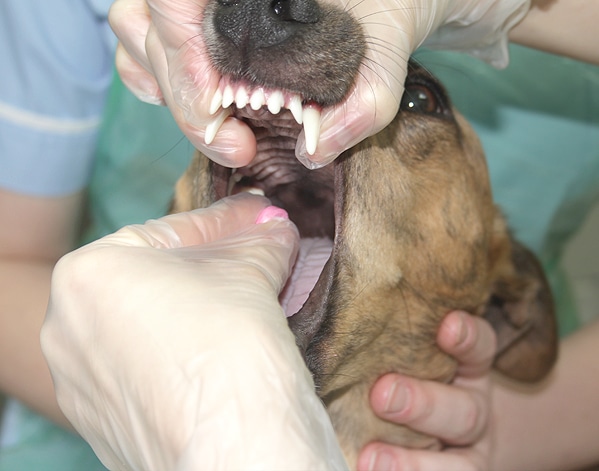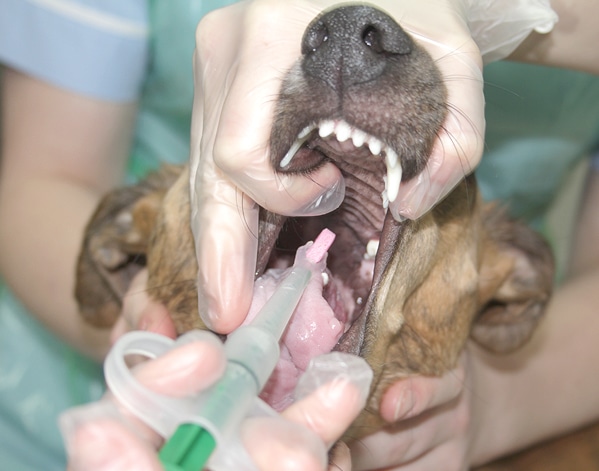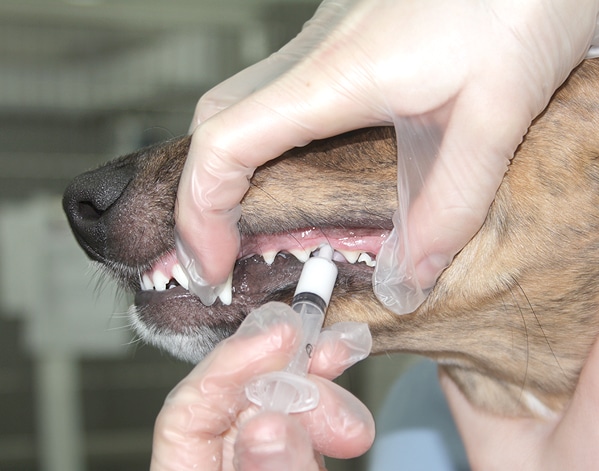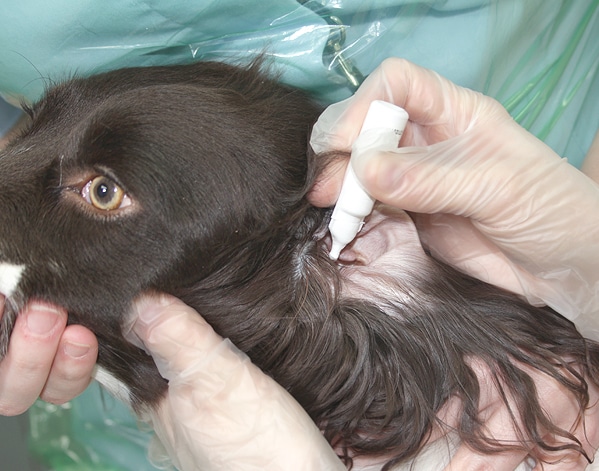
We hope that the following information will help to answer any questions that you may have about administering the medication that the vet has prescribed for your pet.
Your vet or a nurse will be happy to show you how to give medication to your pet – please ask if you would like any assistance. Often it takes two people to give medication – one person to hold your pet and one person to give the medication. Be very careful not to get bitten or scratched.
If you have a cat, it may be necessary to carefully wrap him or her in a towel to prevent scratching.
Don’t forget to offer lots of praise to your pet after giving them their medication as this makes it easier the next time! If you have any queries or concerns about your pet’s medication, then please don’t hesitate to contact us.
Following instructions on the drug label
It is very important to read the drug label carefully and to follow all the instructions. The drug label should contain the following information: your surname and address, your pet’s name, the name of the medication, how much medication you should give and how often the medication should be given.
In addition, the label may say whether it is important for a medication to be given with or without food.
Unless stated otherwise, give all the medication provided as it is very important to complete the course of treatment.
If there is anything on the label that you don’t understand, then please do not hesitate to ask us.
Storing medications
Medications should always be stored out of reach of children.
They should be stored somewhere dry and out of direct sunlight. Most medications can be stored at room temperature, but some need to be kept in the fridge. Special storage requirements should be given on the label.
Handling medications
Always wash your hands after handling any medications and administering them to your pet. Some medications shouldn’t be handled by pregnant women. If you or anybody in your family is or may be pregnant, please check with your vet whether the medication is safe to handle. If there is any doubt, then either wear gloves or don’t handle the medication.
If you have any allergies to medications yourself e.g. penicillin, please inform your vet. We use similar drugs in animals to those used in humans.
Timing of medications
We have a handy Medication Chart available to download. This can help you to plan medication times and acts as a reminder of which medication to give and when. This is particularly useful if your pet is on multiple medications or if different members of the family are involved in giving medications.
Ideally, try to give medications at roughly the same time every day.
Twice daily medication:doses should normally be given 12 hours apart
Three times daily mediation:doses should normally be given 8 hours apart
Four times daily medication: doses should ideally be given 6 hours apart.
Completing the course
It is important to complete the course of medication prescribed, even if your pet appears to be better. Problems can arise if courses of treatment aren’t completed. For example, if a course of antibiotics isn’t completed, this can lead to a recurrence of the disease and also to the development of antibiotic resistant bacteria which are then very difficult to treat. If you are concerned that your pet is suffering from any side effects or that the treatment doesn’t appear to be working, then please contact us for advice.
Repeat prescriptions
When your pet is on long term medication, your vet will advise you how frequently your pet needs to be re-examined. This will often be every 6 months but may well be more often, depending on your pet’s condition.
It is important that your pet is regularly reassessed to determine how well the medication is working, to ensure that the medication is still the most appropriate treatment for your pet’s condition, to determine whether there are any side effects from the medication and to check your pet’s weight to ensure that the dosage of medication is still suitable. You will find that some medications may not be available on repeat prescription. These include antibiotics and some ear and eye medications.
It is necessary for you to give us advance notice (ideally 2 working days) for repeat prescriptions. They cannot always be provided at short notice because the medication you require may not routinely be kept in stock, and the vet will not always be immediately available to issue the repeat prescription.
Refunds on returned medications
We are unable to issue refunds on returned medication. Due to the lack of guaranteed storage conditions, we are unable to re-issue/sell the returned medication to any other pets.
Disposal of unwanted medications
We can safely dispose of any unwanted medications that have been purchased from us.
Side effects
If you are concerned that your pet maybe suffering from any side effects from the medication provided, please contact us.
How to administer oral medication (i.e. medication given by mouth)
Giving tablets
Usually, the easiest way of giving tablets to your pet is to disguise them in food. Most tablets can be given with food. Your vet will inform you whether the tablets prescribed should be given with or without food.
Normally, tablets can be broken up or crushed to hide them in food. Some tablets should not be broken up or crushed as this may decrease their effectiveness, it may make them taste worse or it may not be safe for you to handle the crushed tablets.
You can try hiding the tablet in your pet’s normal food (effective in most dogs) or in a tasty treat (as long as this doesn’t upset their tummy). Try small amounts of cream cheese, pate, chicken, ham, sausage, tuna or prawns. You need to be creative! Try giving a small treat without the tablet first, then a small treat with the tablet and finish with a small treat without the tablet.
If your pet won’t take tablets in food, then you may have to administer them directly. To do this, gently tip your pet’s head backwards so that they are looking at the ceiling. It is then easier to pull the lower jaw down before placing the tablet to the back of the mouth. Close the mouth and then stroke the throat gently to encourage swallowing. ‘Pill poppers’ are available to help administer tablets without getting bitten – they are particularly useful in cats.

Tablets must be pushed over the back of the tongue with the mouth held open. Pulling the head backwards helps to encourage opening of the mouth

A pill popper can be useful in safely getting tablets over the back of the tongue
Some tablets can be crushed, dissolved in water and syringed into your pet’s mouth. Please check with your vet before doing this.
If you are concerned that you will not be able to give tablets to your pet, then discuss this with your vet as there may be other options.
Giving liquid
Usually, the easiest way or giving oral liquid medications is to disguise them in food in a similar way to tablets. Often, they can be squirted directly into your pet’s mouth. The best way to do this is to gently hold you pet’s mouth closed and to insert the syringe or pipette into the corner of your pet’s mouth between the lips and between the teeth. Squirt the medication gently across the tongue, rather than to the back of the throat to prevent the medication going down the airway by mistake. Gently, keep the mouth closed and stroke the throat to encourage swallowing.

Liquid medications can be slowly syringed into the mouth through a gap between the teeth
How to administer ear treatment
Cleaning ears
Cats rarely need their ears cleaning but some dogs are prone to recurrent ear infections and need their ears cleaning regularly. We can provide safe products for cleaning ears. Hold the ear flap up to expose the external ear canal. Carefully place the nozzle of the bottle into the external ear canal and apply the ear cleaner by squeezing the bottle. Gently rub the base of the ear to encourage the cleaner to go down the ear. Be prepared for you pet to shake their head after the cleaner has been applied – it may spray on to you or on to your best furniture and carpets!
Wipe out any accumulated wax with moist cotton wool. Do not use cotton buds down the ear.
Applying ear medication
Please note that most ear medications contain topical steroids and should not be handled by pregnant women.
Hold the ear flap up to expose the external ear canal. Before applying treatment, wipe out any accumulated wax with moist cotton wool. Carefully place the nozzle of the bottle into the external ear canal and apply the prescribed amount of medication. Gently rub the base of the ear to encourage the medication to go down the ear.
If your pet’s ear seems very painful before or after applying ear treatment, please contact us.

Drops being applied to a dog’s ear – the drops should be thoroughly massaged down the ear canal after being instilled
How to administer eye treatment
See our How to administer eye treatment to your pet information page.
How to administer creams and ointments
Please note that many creams and ointments contain topical steroids and should not be handled by pregnant women.
You should wear gloves when applying creams or ointments to your pet’s skin. After application, try feeding, playing or walking your pet to distract them from licking the treated area. Elizabethan collars can also be used to prevent licking.
How to administer insulin injections and the care of insulin
See our Diabetes Mellitus Information page.
If you have any queries or concerns about giving medication to your pet then please do not hesitate to contact us.
Arranging a referral for your pet
If you would like to refer your pet to see one of our Specialists please visit our Arranging a Referral page.